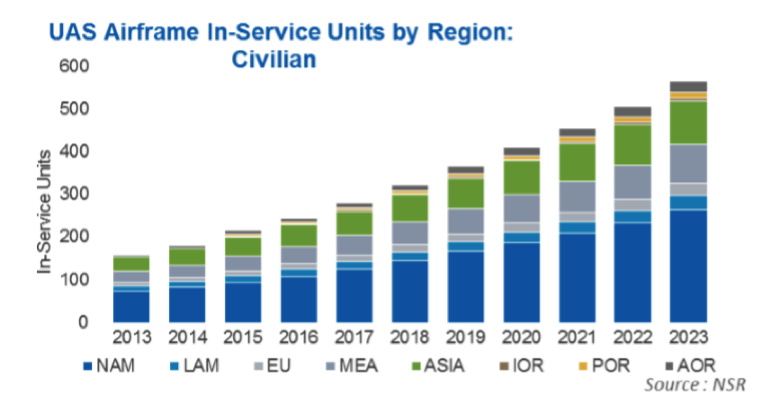Dawn of the ‘Friendly’ Unmanned Aircraft Systems
May 13th, 2015 by
Prateep Basu, NSR
There is no questioning the rise of Unmanned Aircraft Systems (UAS)
worldwide, and their recent use in Nepal after the recent earthquake is
another sign of the UAS surge. A widely untapped aspect of UAS,
civilian government applications such as homeland
security, border protection, scientific experimentation, environmental
monitoring, and peace-keeping missions (to name a few) are being
increasingly performed on are highly capable platforms like the
Predator, Global Hawk, and Heron. The big question that satellite
operators should ponder against this backdrop is – how will it impact
satellite services, for both communications and Earth Observation?
Will these UAS compete with, or be a complement to, or a
customer of satellite services?
Scenario 1: As Complement AND a Competitor
The use of UAS for communication relay is well understood, and
architectural studies have been conducted for integrating stratospheric
UAS with LEO and GEO communication satellites for localized high quality
service. Despite none of these studies leading to implementation, the
announcements and investment by Internet companies such as Facebook and
Google in High Altitude Long Endurance (HALE) UAS for data connectivity
globally has generated renewed interest in this concept. The table below
lists a few popular UAS and High Altitude platform (HAP) programs that
were in the spotlight lately. These UAS can complement and compete with
satellite and terrestrial networks for data and voice communications at
the same time, by acting as a backhaul service for LTE networks.
Given the payload capability, these UAS can also be used as a means
of imaging narrow and wide corridors. Such applications are already
popular in the civilian and commercial value-added EO imagery markets of
Europe, where UAS imagery is used as a complement to medium to high
resolution satellite based imagery.

Scenario 2: As a Customer
The U.S. has taken the lead when it comes to civilian government use
of UAS, with its Border and Customs Forces operating a fleet of 9
Predators, operating in Ku-band and covering from the eastern Pacific
Ocean to the Caribbean. The U.S. Coast Guard and the U.N. forces also
fly HALE and MALE UAS for imagery, communication relay, and live video
broadcasting applications. Israel has used its Heron and Searcher UAS
for border protection since the late 1990s, and other countries have
ramped up buying such UAS, quoting similar civilian government usage.
NSR’s
Unmanned Aircraft Systems via Satellite report forecasts the number
of civilian UAS Satcom units to grow three-fold by 2023. The
maximum growth is expected to be observed in North America, follow by
Asia and Europe, where military UAS units, after completing their
stipulated flight hours, are expected be moved for civilian government
use.

Most of these UAS are expected to continue using Ku-band for
communications as changes in airborne and ground satellite
terminals to higher frequency bands are expensive and beyond the budget
allocation for civilian government UAS operations.
Bottom Line
UAS can be a competitor, customer, or a complement to satellites,
depending on the application for which they are used. The growth in
military UAS is expected to spillover to civilian government use, both
over land and sea. These high performance UAS platforms
provide governments ‘quick action’ capabilities for various civilian
purposes, most important being emergency disaster management operations
and homeland security. As these civilian uses of UAS gain popularity
globally, it presents an opportunity for commercial satellite
operators to capitalize on, due to the expected continued use
of FSS Ku-band by these platforms.
| |

